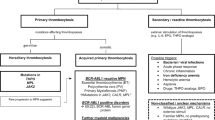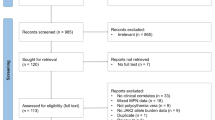Abstract
In patients with cancer and myeloproliferative disorders, leukocytosis has been associated with an increased venous thromboembolic (VTE) risk. Our goal was to determine whether persistent neutrophilia (PN), not associated with known causes such as malignancies, infections or steroids, is independently associated with VTE. All adult patients with >3 outpatient complete blood counts (CBCs) within 3 years were included. PN was defined as having an absolute neutrophil count >95 % (>2SD) of the population (≥7.8 × 109/L) on at least three CBCs, at least 2 months apart. Separate analyses for neutrophil counts ≥9 × 109/L and ≥10 × 109/L were also performed. Blood counts from inpatients were excluded. Primary outcome was diagnosis of VTE, as determined by ICD-9 codes. Odds ratios were adjusted for diabetes, smoking, obesity, gender, and age. Charlson score was utilized as a morbidity measure. Data on 43,538 outpatients were collected. Although there was no association of VTE with neutrophil counts ≥7.8 × 109/L, patients with ≥9.0 × 109/L neutrophils were twice as likely to be diagnosed with VTE compared to those with normal neutrophil counts (OR 2.0, 95 % CI 1.3, 3.1; p = 0.003). Patients with neutrophil counts ≥10.0 × 109/L were at an even higher risk (OR 2.3, 95 % CI 1.2, 4.8; p = 0.019). Charlson scores significantly modified this risk when incorporated into analysis. Elevated neutrophil counts are associated with an increased risk of venous thrombosis even when they are not due to cancer, infection or steroids. In patients with significant comorbidities, neutrophilia may be a marker of VTE risk.


Similar content being viewed by others
References
Carobbio A, Finazzi G, Guerini V, Spinelli O, Delaini F, Marchioli R et al (2007) Leukocytosis is a risk factor for thrombosis in essential thrombocythemia: interaction with treatment, standard risk factors, and Jak2 mutation status. Blood 109:2310–2313
Landolfi R, Di Gennaro L, Barbui T, De Stefano V, Finazzi G, Marfisi R et al (2007) Leukocytosis as a major thrombotic risk factor in patients with polycythemia vera. Blood 109:2446–2452
Palandri F, Polverelli N, Catani L, Ottaviani E, Baccarani M, Vianelli N (2011) Impact of leukocytosis on thrombotic risk and survival in 532 patients with essential thrombocythemia. Ann Hematol 90:933–938
Angona A, Alvarez-Larran A, Bellosillo B, Martinez-Aviles L, Garcia-Pallarols F, Longaron R et al (2015) Essential thrombocythemia: baseline characteristics and risk factors for survival and thrombosis in a series of 214 patients. Med Clin (Barc) 144:247–253
Passamonti F, Caramezza D, Mora B, Casalone R, Maffioli M (2014) Is it time to change thrombosis risk assessment for PV and ET? Best Pract Res Clin Haematol 27:121–127
Buxhofer-Ausch V, Gisslinger H, Thiele J, Gisslinger B, Kvasnicka HM, Müllauer L et al (2012) Leukocytosis as an important risk factor for arterial thrombosis in WHO-defined early/prefibrotic myelofibrosis: an international study of 264 patients. Am J Hematol 87:669–672
Wang Z, Yan HH, Yang JJ, Wang BC, Chen HJ, Zhou Q et al (2015) Venous thromboembolism risk factors in Chinese non-small cell lung cancer patients. Support Care Cancer 23:635–641
Zhang Y, Yang Y, Chen W, Guo L, Liang L, Zhai Z et al (2014) Prevalence and associations of VTE in patients with newly diagnosed lung cancer. Chest 146:650–658
Connolly GC, Khorana AA, Kuderer NM, Culakova E, Francis CW, Lyman GH (2010) Leukocytosis, thrombosis and early mortality in cancer patients initiating chemotherapy. Thromb Res 126:113–118
Blix K, Jensvoll H, Brækkan S, Hansen J (2013) White blood cell count measured prior to cancer development is associated with future risk of venous thromboembolism—The Tromsø Study. PLoS One 8:e73447
Fuchs TA, Brill A, Duerschmied D, Schatzberg D, Monestier M, Myers DD Jr et al (2010) Extracellular DNA traps promote thrombosis. PNAS 107:15880–15885
Borissoff JI, ten Cate H (2011) From neutrophil extracellular traps release to thrombosis: an overshooting host-defense mechanism? J Thromb Haemost 9:1791–1794
Martinod K, Wagner DD (2014) Thrombosis: tangled up in NETs. Blood 123:2768–2776
Massberg S, Grahl L, von Bruehl ML, Manukyan D, Pfeiler S, Goosmann C et al (2010) Reciprocal coupling of coagulation and innate immunity via neutrophil serine proteases. Nat Med 16:887–896
Levi M, van der Poll T, Buller HR (2004) Bidirectional relation between inflammation and coagulation. Circulation 109:2698–2704
Ruf W, Ruggeri ZM (2010) Neutrophils release brakes of coagulation. Nat Med 16:851–852
Ruggeri ZM (2007) The role of von Willebrand factor in thrombus formation. Thromb Res 120(Suppl 1):S5–S9
Jimenez-Alcazar M, Napirei M, Panda R, Kohler EC, Kremer-Hovinga JA, Mannherz HG et al (2015) Impaired DNase1-mediated degradation of neutrophil extracellular traps is associated with acute thrombotic microangiopathies. J Thromb Haemost 5:732–742
von Bruhl ML, Stark K, Steinhart A, Chandraratne S, Konrad I, Lorenz M et al (2012) Monocytes, neutrophils, and platelets cooperate to initiate and propagate venous thrombosis in mice in vivo. J Exp Med 209:819–835
Semeraro F, Ammollo CT, Morrissey JH, Dale GL, Friese P, Esmon NL et al (2011) Extracellular histones promote thrombin generation through platelet-dependent mechanisms: involvement of platelet TLR2 and TLR4. Blood 118:1952–1961
Savchenko AS, Martinod K, Seidman MA, Wong SL, Borissoff JI, Piazza G et al (2014) Neutrophil extracellular traps form predominantly during the organizing stage of human venous thromboembolism development. J Thromb Haemost 12:860–870
Borissoff JI, Joosen IA, Versteylen MO, Brill A, Fuchs TA, Savchenko AS et al (2013) Elevated levels of circulating DNA and chromatin are indepndently associated with severe coronary atherosclerosis and a prothrombotic state. Arterioscler Thromb Vasc Biol 33:2032–2040
van Montfoort ML, Stephan F, Lauw MN, Hutten BA, Van Mierlo GJ, Solati S et al (2013) Circulating nucleosomes and neutrophil activation as risk factors for deep vein thrombosis. Arterioscler Thromb Vasc Biol 33:147–151
Brill A, Fuchs TA, Savchenko AS, Thomas GM, Martinod K, De Meyer SF et al (2012) Neutrophil extracellular traps promote deep venous thrombosis in mice. J Thromb Haemost 10:136–144
Stakos DA, Kambas K, Konstantinidis T, Mitroulis I, Apostolidou E, Arelaki S et al (2015) Expression of functional tissue factor by neutrophil extracellular traps in culprit artery of acute myocardial infarction. Eur Heart J 36:1405–1414
Martinod K, Demers M, Fuchs TA, Wong SL, Brill A, Gallant M et al (2013) Neutrophil histone modification by peptidylarginine deiminase 4 is critical for deep vein thrombosis in mice. PNAS 110:8674–8679
Olson NC, Cushman M, Lutsey PL, McClure LA, Judd S, Tracy RP et al (2014) Inflammation markers and incident venous thromboembolism: the reasons for geographic and racial differences in stroke (REGARDS) cohort. J Thromb Haemost 12:1993–2001
Wang TF, Wong CA, Milligan PE, Thoelke MS, Woeltje KF, Gage BF (2014) Risk factors for inpatient venous thromboembolism despite thromboprophylaxis. Thromb Res 133:25–29
Borch KH, Braekkan SK, Mathiesen EB, Njølstad I, Wilsgaard T, Størmer J et al (2010) Anthropometric measures of obesity and risk of venous thromboembolism: the Tromso study. Arterioscler Thromb Vasc Biol 30:121–127
Ay C, Tengler T, Vormittag R, Simanek R, Dorda W, Vukovich T et al (2007) Venous thromboembolism—a manifestation of the metabolic syndrome. Haematologica 92:374–380
Jang MJ, Choi WI, Bang SM, Lee T, Kim YK, Ageno W et al (2009) Metabolic syndrome is associated with venous thromboembolism in the Korean population. Arterioscler Thromb Vasc Biol 29:311–315
Di Minno MN, Tufano A, Guida A, Di Capua M, De Gregorio AM, Cerbone AM et al (2011) Abnormally high prevalence of major components of the metabolic syndrome in subjects with early-onset idiopathic venous thromboembolism. Thromb Res 127:193–197
Vaya A, Martinez-Triguero ML, Espana F, Todolí JA, Bonet E, Corella D (2011) The metabolic syndrome and its individual components: its association with venous thromboembolism in a Mediterranean population. Metab Syndr Relat Disord 9:197–201
Stein PD, Goldman J, Matta F, Yaekoub AY (2009) Diabetes mellitus and risk of venous thromboembolism. Am J Med Sci 337:259–264
Petrauskiene V, Falk M, Waernbaum I, Norberg M, Eriksson JW (2005) The risk of venous thromboembolism is markedly elevated in patients with diabetes. Diabetologia 48:1017–1021
Steffen LM, Cushman M, Peacock JM, Heckbert SR, Jacobs DR Jr, Rosamond WD et al (2009) Metabolic syndrome and risk of venous thromboembolism: longitudinal investigation of thromboembolism etiology. J Thromb Haemost 7:746–751
Ageno W, Prandoni P, Romualdi E, Ghirarduzzi A, Dentali F, Pesavento R et al (2006) The metabolic syndrome and the risk of venous thrombosis: a case–control study. J Thromb Haemost 4:1914–1918
Eichinger S, Hron G, Bialonczyk C, Hirschl M, Minar E, Wagner O et al (2008) Overweight, obesity, and the risk of recurrent venous thromboembolism. Arch Intern Med 168:1678–1683
Weir AB, Lewis JB Jr, Arteta-Bulos R (2011) Chronic idiopathic neutrophilia: experience and recommendations. South Med J 104:499–504
Herishanu Y, Rogowski O, Polliack A, Marilus R (2006) Leukocytosis in obese individuals: possible link in patients with unexplained persistent neutrophilia. Eur J Haematol 76:516–520
Vaidyula VR, Rao AK, Mozzoli M, Homko C, Cheung P, Boden G (2006) Effects of hyperglycemia and hyperinsulinemia on circulating tissue factor procoagulant activity and platelet CD40 ligand. Diabetes 55:202–208
Ray JG, Lonn E, Yi Q, Sheridan P, Kearon C, Yusuf S, Arnold MJ, McQueen MJ, Pogue J, Probstfield J, Fodor G, Held C, Micks M, Genest J Jr, HOPE-2 investigators (2007) Venous thromboembolism in association with features of the metabolic syndrome. QJM 100:679–684
Thobakgale CF, Ndung’u T (2014) Neutrophil counts in persons of African origin. Curr Opin Hematol 21:50–57
Mazurek JA, Hailpern SM, Goring T, Nordin C (2010) Prevalence of hemoglobin A1c greater than 6.5 and 7.0 % among hospitalized patients without known diagnosis of diabetes at an urban inner city hospital. J Clin Endocrinol Metab 95:1344–1348
Funding
This publication was supported in part by the CTSA Grant UL1 RR025750, KL2 RR025749 and TL1 RR025748 from the National Center for Research Resources (NCRR), a component of the National Institutes of Health (NIH), and NIH roadmap for Medical Research. Its contents are solely the responsibility of the authors and do not necessarily represent the official view of the NCRR or NIH. The funders had no role in study design, data collection and analysis, decision to publish, or preparation of the manuscript.
Author information
Authors and Affiliations
Corresponding author
Ethics declarations
Conflict of Interest
The authors declare that they have no conflict of interest.
Rights and permissions
About this article
Cite this article
Kushnir, M., Cohen, H.W. & Billett, H.H. Persistent neutrophilia is a marker for an increased risk of venous thrombosis. J Thromb Thrombolysis 42, 545–551 (2016). https://doi.org/10.1007/s11239-016-1398-4
Published:
Issue Date:
DOI: https://doi.org/10.1007/s11239-016-1398-4




